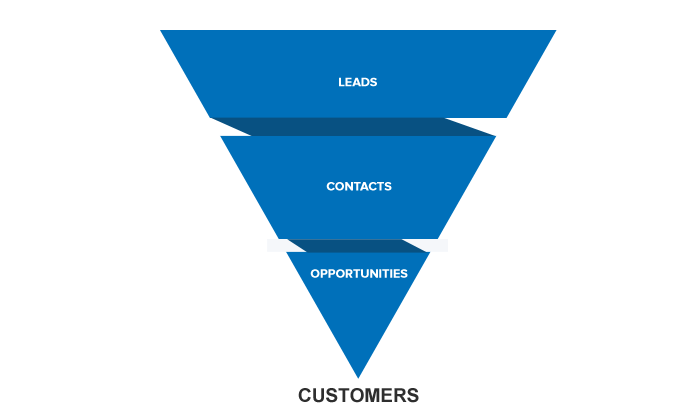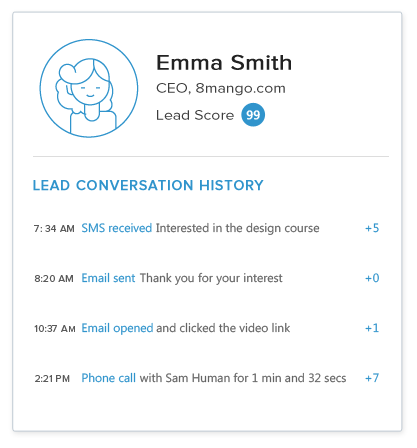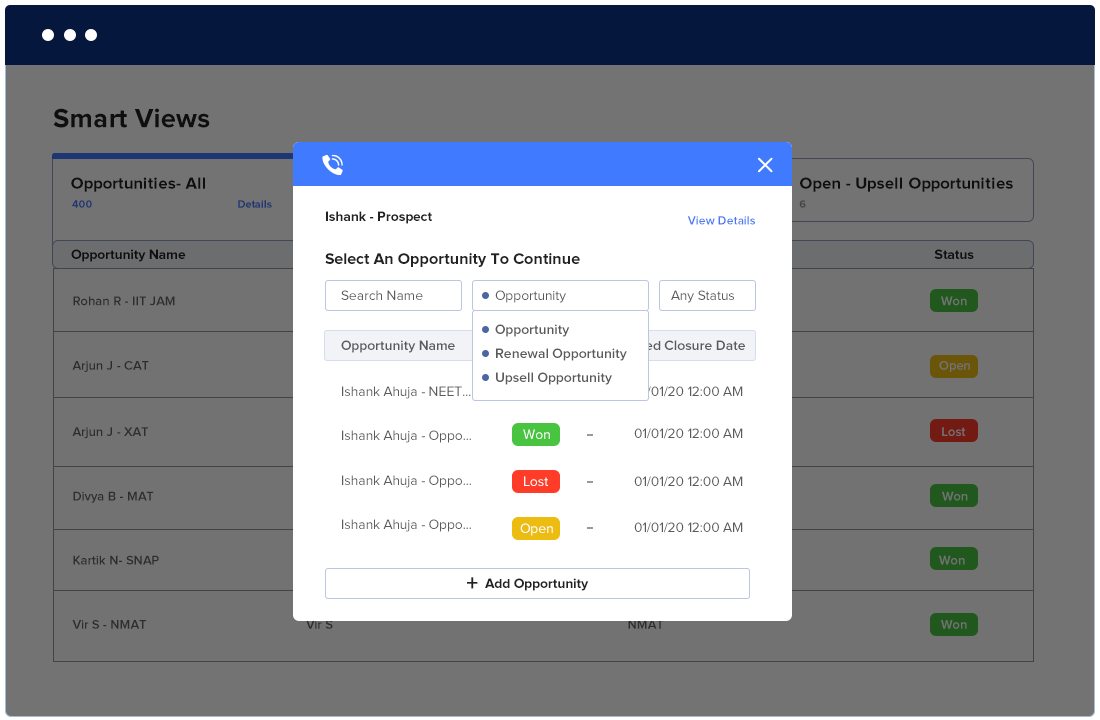Often sales and marketing professionals get confused between contact management and opportunity management. While they look similar, there is a fine line between the two processes. By understanding the difference between contact management and opportunity management, you can nurture them better. You will also be able to utilize your resources optimally.
So, let us dive in. But first, a quick look at the basics.
Difference Between Contact and Opportunity
Take note. Different people define contact and opportunity differently. Some sources define a lead as a contact. Similarly, there are ambiguities in the definitions of contacts and opportunities.
To avoid such confusion here is a simple way to understand them.
Contact: Suppose you have some details (email id, phone number) of a prospective buyer. It is a lead. We cannot call it a contact yet. Leads become contacts when there is two-way communication. This communication is between the business and the individual.
I repeat – a lead is not a contact. It becomes a contact when the lead shows interest, and the salesperson follows up. Even an old customer is contact because they have shown interest in your business.
Opportunity: On the other hand, the advanced state of contact is the opportunity. At this stage, the salesperson potentially sees the chances of closure. Here, the lead and the sales representative are in the final stage of discussion (terms of service, pricing, and so on). Also, note, opportunity can be an existing customer as well. That is, your customer can buy from you again.

Of course, both contact and opportunity are interconnected and closely related. But this is the main difference between contact and opportunity.
What is the Primary Difference Between Contact Management and Opportunity Management?
Contact management is the process of organizing and managing contacts. It involves tracking and engaging with your potential customers. Engagement with them is crucial to determine which leads are most likely to buy. Therefore, it allows the sales team to prioritize follow up. Once you identify the qualified leads, you can also reduce the length of your sales cycle.
Businesses generally use contact management software for managing the details of their prospective and existing customers. Nowadays, they prefer managing contacts through CRM (Customer Relationship Management) software as it provides additional features.
Now let us move on to – what is opportunity management?
Ideally, you want your salesperson to focus on the highest value deals. You want to spend energy on the deals that are most likely to close. Now, this is where opportunity management comes into the picture. Depending on their stage in your sales funnel, you can determine how close you are to close the deal.
Plus, opportunity management also involves identifying cross-selling and upselling possibilities. For instance, a contact can be a prospective customer for multiple products. Opportunity management also corresponds to mapping different opportunities associated with a contact – without creating duplicate records.
Many mature CRM tools have opportunity management as an in-built feature. For example, LeadSquared opportunity management CRM lets you capture, track, and close all opportunities from every single contact. It allows teams to manage multiple products and spot upsell/cross-sell opportunities to increase your CLV (Customer Lifetime Value).
In a nutshell, contact management is the process of organizing and managing contacts. On the other hand, opportunity management is the process of focusing on those contacts where you are most likely to close a deal.
Who Should Care About Contact and Opportunity Management?
Contact management is of great importance for both sales and marketing professionals. Your marketing team wants to know more information about the contact. Information such as location, preferences, and other details helps them in designing effective marketing campaigns.
On the other hand, the sales team wants to know the contacts for linking them to opportunities. It helps them in identifying potential sales opportunities. All this information helps sales reps in building long-term relationships with contacts. It eventually leads to more revenues from their referrals.
Now you know what is the primary difference between contact management and opportunity management, right? Let us move on to the key features of the software designed to accomplish these tasks.
Key Features of Contact Management System
1. Notifications
The contact management system allows you to integrate with the calendar. Thus, you can stay on top of calls, follow-ups, and emails. Rather than relying on memory or lengthy spreadsheets, the contact management system will set up activity notifications. Thus, allowing you to manage all queries and concerns appropriately. Through calendar integration, sales teams can achieve more transparency in their process.

2. Interaction History
The contact management system helps in keeping track of customer interaction through notes and timestamps. It gives the real picture of the conversation history to all the associated team members.
Let us take an example.
When a sales rep is on leave, usually another team member follows up with the customer. Through contact management software, they get a complete picture of the activities and interactions with the customer. Thus, helping the sales rep to deal with customers effectively. For instance, when a customer asks about repairs, sales reps can look at interaction history. It will help them know if it is the first time they are asking for repairs. Such details can help sales reps to better attend to customers.

3. Customer Database
The customer database is the fundamental aspect of a contact management system. However, it is also the most prominent feature. If you have customer information, you can do several things. For instance, you can directly contact them with promotional offers and discounts. You can offer a customized level of service based on their preferences. You can also use the details to reduce the churn rate and encourage brand loyalty.
Please note, professionals generally prefer CRM software these days over a standalone contact manager. It is because, apart from effective contact management, they can do a lot more through CRM. For example:
- Automate sales and marketing processes
- Define automated workflows
- Integrate with telephony and cloud calling systems for direct calling through the portal
- Integrate with email service providers like Gmail, Outlook, and more.
[Also read: customer database in CRM]
Key Features of Opportunity Management System
1. Enhanced Productivity
An opportunity management system can help sales reps manage their work efficiently. They can arrange meetings with potential leads as well as manage documents from the same portal. Moreover, through collaboration, sales reps can streamline the sale
s cycle. Also, opportunity management systems automate lead scoring and lead prioritization to identify the opportunities from every contact. Thus, boosting the overall productivity of your business.
2. Improve Win Rates
An opportunity management system also improves your business win rates. Using this system, you are in a better position to understand what works and what does not. You know what you need next to boost your opportunity win rates.
It highlights another big difference between contact management and opportunity management. Contact management brings you customer information, while opportunity management drives revenues.
3. Gain Real-time Visibility
For sales reps, it is imperative to gain real-time visibility. When you have details on forecasts, it becomes easy for businesses to predict sales. The opportunity management system sends you signals when a contact performs an activity such as clicks ads, browses your website for product info, drops you a query, and more. Moreover, the system helps you to focus only on the opportunities which matter the most. It is yet another difference between opportunity management and contact management. The contact management system does not allow you to predict the sales pipeline.

Hopefully, now you have a clear understanding of the differences between the two.
Final Thoughts
Contact management and opportunity management are interconnected parts of the sales process. Although they sound similar, there are several differences between the two. While contact management helps you organize and manage customer details efficiently, opportunity management uses those details to generate business revenues.
When sales reps get easy access to customer data, they can reduce sales cycles by 8% to 14%. Moreover, such a system can also improve sales forecast accuracy by as much as 42%. That said, it can also increase sales and sales productivity at your organization. Therefore, businesses must use such systems.
When both contact management and opportunity management are crucial for your business, instead of looking for separate tools, it is wiser to invest in CRM software that streamlines both processes.
Fortunately, we have a tool – designed specifically for growing businesses. So, give your hunt a halt. Book a Demo!









